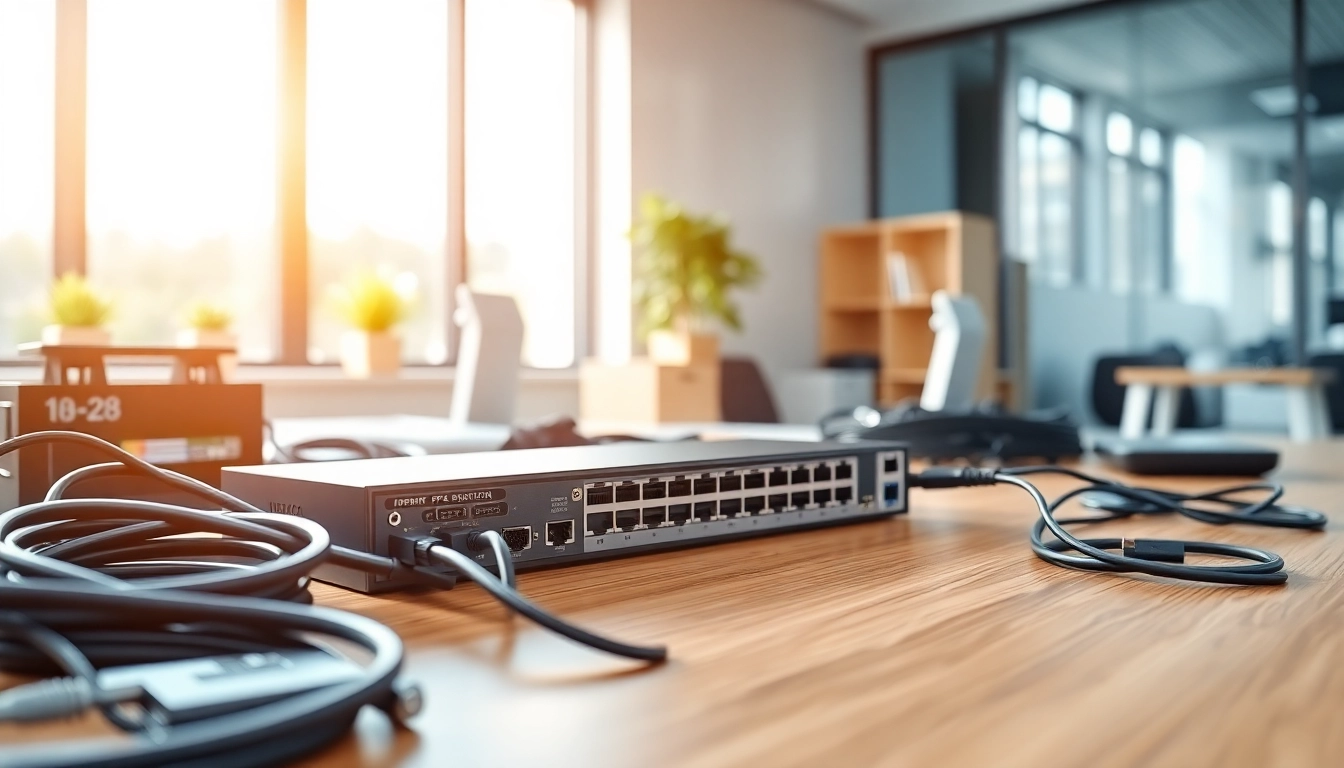Introduction to POE Switch
In today’s data-driven world, network efficiency has become pivotal for businesses and home users alike. A key component in modern networking setups is the POE Switch, a device that not only helps in connecting wired devices but also simplifies the power management for devices such as IP cameras, wireless access points, and VoIP phones through a single cable. This article delves into the functionalities, benefits, types, applications, installation, and troubleshooting of POE switches, offering comprehensive insights to help you make informed decisions.
What is a POE Switch?
A POE switch is a type of network switch that uses Power over Ethernet (PoE) technology to deliver both power and data to connected devices through standard Ethernet cables. This innovation allows for the simplification of network design and reduces the need for separate power outlets for devices, ultimately streamlining installation and maintenance.
How POE Switch Works
The way a POE switch operates is intriguing. Standard Ethernet can transmit data at various speeds, with the most common being 10/100 Mbps. With PoE technology, the switch sends electrical power along with data through the Ethernet cable. When a powered device (PD) such as a security camera or an IP phone is connected to a POE switch, the switch performs a detection process to ascertain if the PD is PoE compliant and how much power it requires. The power and data are transmitted over the same cable, typically using two modes: Mode A (power on data pairs) and Mode B (power on spare pairs).
Benefits of Using a POE Switch
- Streamlined Installation: Reduces the complexity of cabling by combining power and data into one cable.
- Flexibility: Allows for the placement of devices in locations without power outlets, enhancing layout options.
- Cost-Effective: Minimizes installation costs as fewer cables and outlets are needed.
- Safety: PoE switches feature safeguards such as short circuit protection and overload protection.
- Scalability: Easy to add or move devices without worrying about power sources.
Types of POE Switch
Standard POE Switch vs. POE+
When exploring POE switches, understanding the differences between standard POE and PoE+ is crucial. The standard POE (IEEE 802.3af) can deliver up to 15.4 watts of power per port, suitable for devices that have lower power requirements, such as IP phones and some lower-end IP cameras. On the other hand, POE+ (IEEE 802.3at) can deliver up to 30 watts per port, allowing it to power more demanding devices, including high-definition security cameras and wireless access points.
Managed vs. Unmanaged POE Switch
POE switches can be categorized into managed and unmanaged types. Managed POE switches allow for greater control over the network traffic. This includes advanced features like VLAN support, port mirroring, and network monitoring, making them suitable for larger networks where traffic management is essential. Unmanaged POE switches are typically plug-and-play units that do not require configuration, making them ideal for smaller setups or where simple connectivity is needed.
Choosing the Right POE Switch
Selecting the right POE switch involves assessing your specific networking needs. Consider the number of devices you plan to connect, their power requirements, and whether you need managed or unmanaged capabilities. Take into account additional features such as port speed, total power budget, and any potential future scalability to ensure you invest in a solution that meets current and future demands.
Applications of POE Switch
POE Switch for IP Cameras
Security is a prime concern for both residential and commercial setups. A POE switch is instrumental in deploying IP cameras, allowing them to receive power and transmit video data simultaneously. This capability simplifies installation, eliminating the need for separate power adapters or outlets, thus enhancing the camera’s placement flexibility.
POE Switch in Wireless Networks
In the era of mobile connectivity, establishing robust wireless networks has become vital. A POE switch can power wireless access points (WAPs) without requiring extensive wiring for power sources. This application is particularly beneficial in large spaces such as offices, schools, and public areas where optimal placement of WAPs ensures better coverage and connectivity.
POE Switch for VoIP Phones
VoIP (Voice over Internet Protocol) phones are widely used for communication in businesses. Connecting VoIP phones to a POE switch provides a hassle-free installation experience while ensuring that the devices remain operational during power outages, provided that the switch is connected to an uninterruptible power supply (UPS). This leads to improved reliability and communication stability.
Installation Guide for POE Switch
Preparing for Installation
Before installing a POE switch, it’s important to assess the area and plan the network design. Identify where devices will be placed and avoid running cables through areas susceptible to interference. Gather all the necessary tools, including Ethernet cables, cable ties, and a power source. Ensure that your POE switch’s specifications align with the device requirements in terms of power and connectivity.
Connecting Devices to the POE Switch
To connect devices to a POE switch, follow these steps:
- Connect the POE switch to your network’s router with an Ethernet cable.
- Using compatible Ethernet cables, connect your powered devices to the switch’s POE ports.
- Plug in the switch to an appropriate power source.
- Monitor the LED indicators on the switch to ensure connections are recognized and devices are powered adequately.
Common Installation Mistakes to Avoid
While installing a POE switch, there are several common mistakes to avoid:
- Poor Cable Management: Neglecting cable organization can lead to tangled wires and connectivity issues.
- Using Incompatible Devices: Ensure that all devices connected to the POE switch are PoE-compatible to prevent damage.
- Overloading Power Budgets: Be mindful of each port’s power capabilities to avoid overloading the switch.
- Ignoring Network Design: Adequate planning of the network can greatly enhance performance and usability.
Troubleshooting POE Switch Issues
Identifying Common Problems
Network issues can arise from a variety of sources. Common problems with POE switches include connectivity failures, devices not powering up, and performance bottlenecks. Recognizing and diagnosing these issues in a timely manner is essential for network reliability.
Step-by-Step Troubleshooting Guide
If you encounter issues with your POE switch, follow these troubleshooting steps:
- Check power supply connections to the switch.
- Ensure that all Ethernet cables are functioning and securely connected.
- Verify device compatibility with PoE standards.
- Observe LED indicators for any alerts or notifications of errors.
- Consult device manuals or manufacturer specifications for specific troubleshooting tips related to the connected devices.
When to Seek Professional Help
If problems persist beyond simple diagnostics, it may be time to seek professional help. Engaging an IT expert can provide deeper network analysis, particularly in larger systems where multiple factors might be affecting performance. Ensuring a solid network infrastructure allows for smoother operations and greater efficiency.



